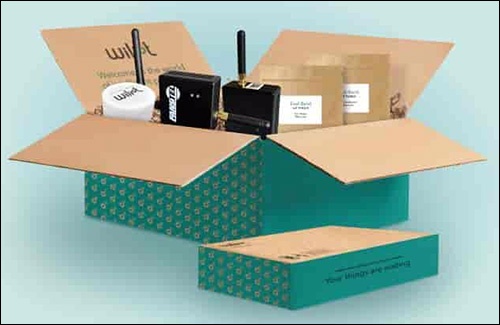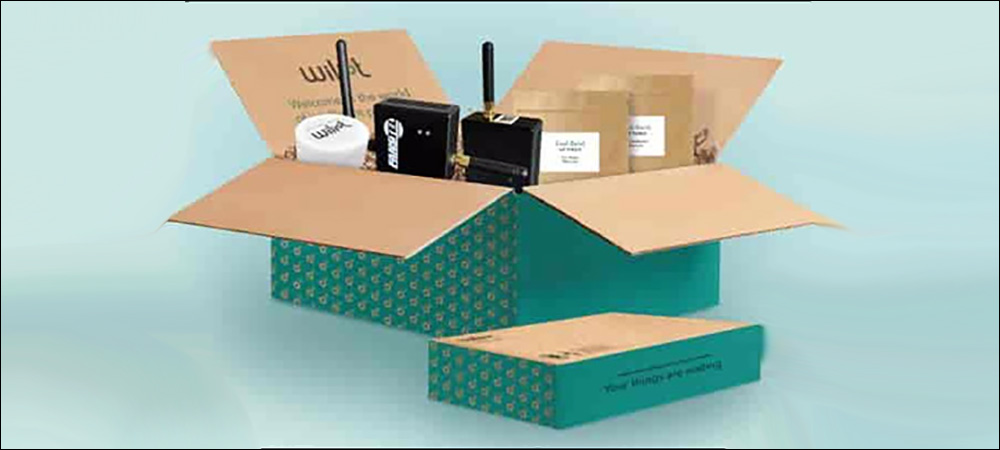- Building Partnership Ahead of Growth
- Automated Brokering for BLE or RFID Solutions
- Returnable Plastic Crate Management
Internet of Things (IoT) technology company Wiliot reports that it is forging ahead with a growth plan that includes partnering with technology makers and solution providers to help customers easily access the support they need for specific solutions or products leveraging passive Bluetooth Low Energy (BLE) sensors. The partnership, unveiled on Apr. 26, is aimed at automating the process of linking customers with solution providers, as well as helping the later adopt and sell Wiliot technology. The scheme is known as Works with Wiliot (WwW).

Wiliot Partner Enablement Kit
Printer and labelling systems company SATO is a member of the program and developed smart appliance solutions using Wiliot’s passive BLE sensor tags to identify tagged items in refrigerators. In addition, software solutions company Tactical Edge offers real-time supply chain management and monitoring applications, while other members that have joined include Sensize, Digipal, VisionID, MLINK, Blyott and Codegate. In April, Avery Dennison Smartrac also announced a partnership with Wiliot, by which the global RFID tag and IC company will begin manufacturing tags leveraging Wiliot’s technology. Avery Dennison also intends to distribute Wiliot tags and provide its own research and development support to create new applications for Wiliot’s technology.
Wiliot has a goal of serving multiple industries with its IoT Pixel cloud-based software and its sticker-sized battery-free sensors that transmit data via BLE, according to Steve Statler, the company’s senrior VP of marketing. The goal, he says, is to track everything at the item level, from returnable transport items and computer chips to food products, pharmaceuticals and apparel. To accelerate new WwW partnerships, Wiliot has launched its Partner Enablement Kit, designed to help prospective partners develop solutions. The kit comes with a year of Wiliot cloud service, as well as IoT Pixels, bridge and gateway devices, the Wiliot Starter Kit, and access to the company’s community forum and support portal.
The software-as-a-service company’s platform connects the digital and physical worlds, the firm reports, by managing data from wireless sensors. Its Universal Automation Platform is intended to be easy to deploy and operate; businesses can simply drag and drop automated actions, triggered by sensing events, while leveraging a library of existing enterprise applications. This follows years of development and deployments among large businesses since Wiliot’s 2017 founding and the release of its first products in 2019.
“We’re growing up,” Statler says. “We started off with a small number of very large companies, and it’s clear that this platform technology can be used for thousands—if not hundreds of thousands—of different things.” He says customers have indicated that a broad platform approach would be the one that wins, adding, “That’s essentially what this partner releases is. If we’re going to do more than just one or two things, we have to do it with partners.” Thus, the effort is underway to make partnership and connections automatic.
Building Partnership Ahead of Growth

Steve Statler
Already, the company has offered a partner portal and dedicated partner recruitment resources. “Our go-to-market approach has changed,” Statler says, “from purely major accounts, directly, to recruiting a variety of different kinds of partners that will allow this technology to be very broadly adopted.” The company now seeks partnerships from all members of the RFID and BLE ecosystem, he adds.
Manufacturers of RFID tags, for instance, are building BLE-based passive tags with Wiliot’s technology, using their existing RFID tag-making process. That, Statler explains, offers alternative products that may be focused on BLE-based applications such as customer-facing data (the tags can be interrogated via a smartphone) or systems with which low-cost beacon receivers would be more affordable than an RFID network of readers.
Wiliot is especially targeting systems integrators and solution providers, Statler says, including companies that offer RFID and Bluetooth-based automatic-identification systems. As part of the partnership, Wiliot will act as broker, connecting these solution providers with customers or suppliers. “We will play the role of being a kind of a marriage broker between customers and partners,” he states. Ultimately, that will be automated on the company’s website.
Automated Brokering for BLE or RFID Solutions

Peter Vitale
Typically, Statler says, when potential customers visit technology websites seeking partnering companies, they tend to find generic statements indicating what those businesses do. The Wiliot program will do more than that, he adds, by drilling into specifics so customers can learn about and identify the best solution provider for their needs. “What we’re doing,” he explains, “is finding the right person and making sure that you actually get to who you need to speak to.”
Additionally, Statler says, those looking to become partners can use the company’s evaluation kit to sample a migration of the BLE data to their existing software. Wiliot will shadow partners and work alongside them in their early projects, so that the partners can get up to speed with the technology. Some RFID tag makers are among the interested partners, Statler reports. There are applications that lend themselves to BLE tags, he adds, including systems by which items need to be tracked from production or harvesting to consumer, with the tags being interrogated via smartphones.
“We’re seeing there’s some very large [end-user] companies that have stated they’re adopting RFID,” Statler states, “but they’re also seeing limitations in that, and so their ability to leverage and have the two solutions work alongside each other is really helpful.” One area of exceptional growth for Wiliot’s technology, the company reports, has been the tracking of plastic crates used to transport items. BLE passive tags serve as a low-cost, battery-free way to obtain data about the locations of such items, and the goods loaded within them, based on data captured by cell phone reads or inexpensive beacon devices.
Returnable Plastic Crate Management
These plastic crates can travel from farm to store, as well as from a store to a consumer’s home. “We’ve seen RFID on the plastic crates and pallets,” Statler says, “but the challenge has been the cost of the infrastructure, so [RFID technology use] is not widespread. I would say 99 percent of plastic crates are in the dark, offline, while 1 percent have an RFID tag, which is essentially using a batch-mode way of tracking it.” With BLE on each crate and the visibility the technology provides, he says, users can start to save money on crates, as well as what’s inside them.
One business that has been part of the partnership program is Tactical Edge, which offers customized software and data-management solutions designed to reduce costs, optimize business processes and extend system lifespans. The company’s Total Visibility Anywhere (TVA) application is a real-time supply chain management and monitoring application that offers organizations a precise view into supply, distribution and transportation activities. The firm seeks to bring flexibility to its solution, says Peter Vitale, Tactical Edge’s COO and founder, adding, “The Wiliot tags fill an important niche in tagging, tracking and identifying items across the supply chain.”
Vitale says the partnership “is immensely valuable, as it provides us the agility to span the global supply chain in a consistent manner and gives Tactical Edge new opportunities for building capabilities in the TVA system.” The company’s technology not only captures and manages read data, he notes, but also seeks to determine the context of movements, or the lack thereof, as well as the meaning of this information.
Through the evaluation and processing of sensor and spatial data, Vitale reports, Tactical Edge brings new insights to Wiliot’s customers. For example, he says, using Wiliot for continual warehouse inventory monitoring would be difficult and expensive with traditional item-tagging solutions. “With Wiliot, we tag material in inventory and receive constant feedback on the material position and availability,” he states. “This allows our customers to shift to ‘inventory by exception,’ which greatly reduces the staff time and costs related to inventory cycle-count activities.”
SATO, another partnership member, is among the industry’s leading providers of auto-ID solutions involving integrated printers and smart labels. Since 2018, the firm has been building solutions that leverage the sensor tags as part of Wiliot’s Early-Advantage partnership program. “Working with Wiliot leverages SATO’s expertise in Bluetooth, RFID [and] vertical applications,” says Kazuya Hirata, SATO’s senior manager for consumer business development.
The company has been undertaking pilots and demonstrating technology use throughout the past few years. “It’s part of our effort to spread the use of BLE technology by getting it recognized by consumers and other stakeholders,” Hirata explains. Because tags use Bluetooth signals that are present everywhere, he says, “I think the potential is huge, and I hope they will be useful in general goods, as well as foods.”
Key Takeaways:
- BLE sensors are poised to provide item-level tracking of high- and low-value goods, and Wiliot plans to encourage and serve that growing demand through partnerships.
- Companies like SATO and Tactical Edge are building solutions that leverage the passive, stamp-sized sticker labels to provide low-cost, wireless tracking of goods in transit, all the way to consumer.
Exhibitors at RFID Journal LIVE! 2022 will offer passive BLE sensors. To learn more, visit the event’s website.


